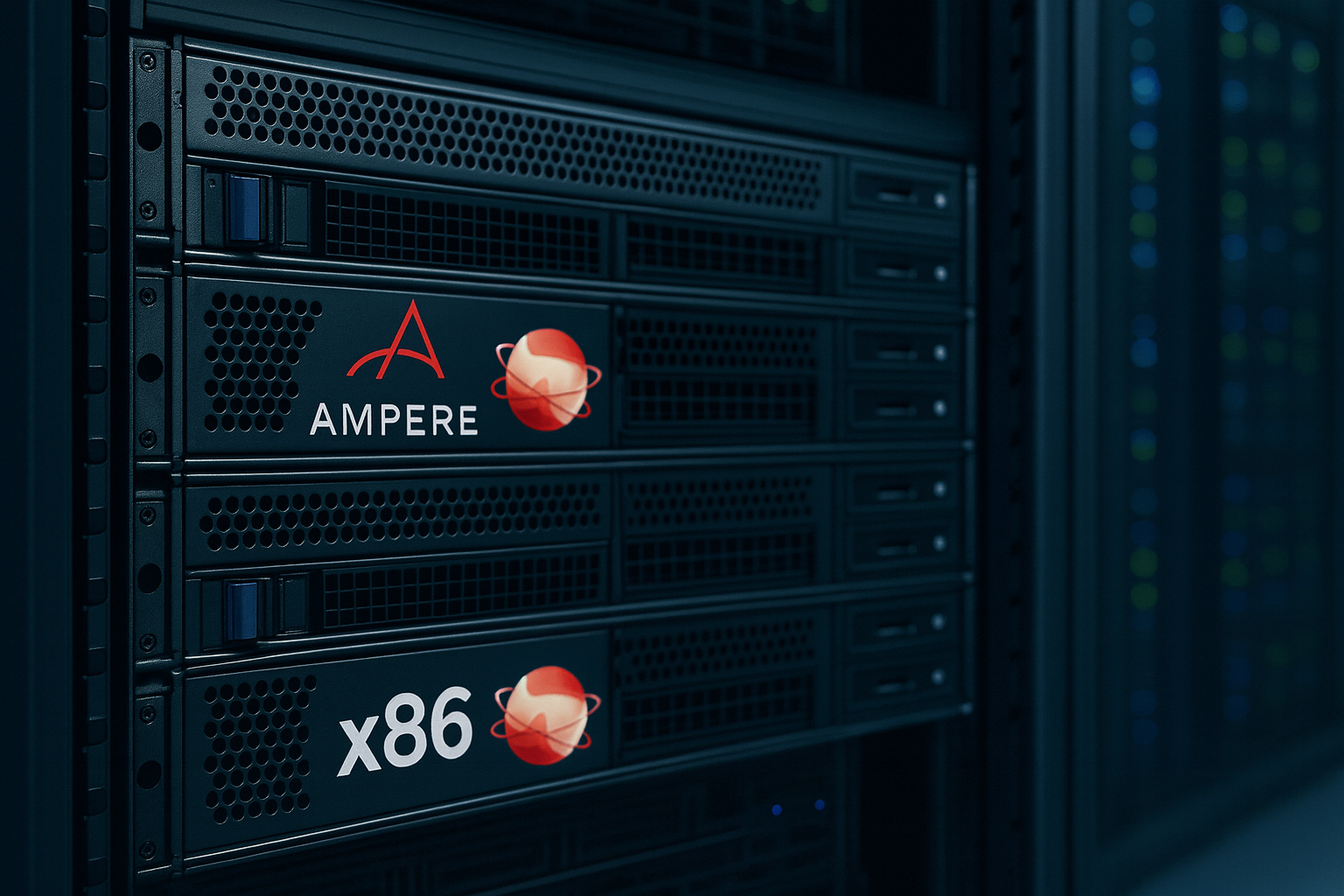Ampere ARM servers: Opening the door to more choices in the datacenter
VATES VMS on Ampere ARM processors demonstrates virtualization diversity, enabling organizations to cut TCO and energy costs while using unified management for their complex, modern cloud workloads.

KubeCon 2025 in Atlanta gave us the opportunity to show something we’ve been working on for quite a while: VATES VMS running on Ampere ARM servers.
Even if it was “just” a demo, it drew a lot of people to the booth. Some were surprised to see everything running live on Ampere ARM; others immediately wanted to know how far along the port was. And rightly so, because in fact, this demonstration marks another step toward the fully production-ready ARM version of the platform we expect to bring to market in 2026.
What follows here is about what this work enables, how it fits into real infrastructure planning, and where it might matter for organizations thinking about their next architecture choices. If you’re interested in the story that brought us here and all the engineering details, the XCP-ng team published a deep dive on their blog.
Broadening the Architecture Landscape
x86 has been the center of gravity for virtualization for years. But with what we showed at KubeCon NA 2025, you can start imagining the flexibility of a multi-architecture datacenter where ARM-based servers sit next to traditional systems.
Running VMS on Ampere unlocks access to the whole Ampere ecosystem, not just one experimental dev board. For example, platform designers such as SuperMicro, System76, Gigabyte, HPE and others are part of this landscape, so organizations can think in terms of actual racks, not lab benches.
And it’s not only about hardware diversity. Some teams simply want to reduce architectural lock-in, or explore designs that behave differently under virtualized workloads. ARM architecture gives you that angle. This milestone doesn’t claim “mission accomplished”, but it shows that this path is real and is a credible option.
A Complete, Integrated Platform
VATES VMS is much more than a hypervisor. It’s a whole virtualization stack: Xen Orchestra for management and automation, built-in backup, proxy layer, HCI-ready storage, monitoring, update workflows, etc. It’s the combination of these that makes the platform workable in production.
Getting this entire stack to run on Arm64 CPUs from Ampere Computing is a meaningful milestone. The VMS experience is already visible, and moving toward a point where the user experience on ARM resembles what teams already know from x86. This matters for organizations is about making ARM a practical choice rather than a lab experiment.
Sustainability and Efficiency
One of the strongest business‐case dimensions for ARM and Ampere Computing CPUs is performance-per-watt, which translates into lower power draw, reduced cooling overhead, potentially smaller rack footprint, and thus lower Total Cost of Ownership (TCO). From the engineering blog article:
“… ARM server processors, with their high core counts and strong energy efficiency, match the requirements of virtualized workloads by offering excellent density and reduced power consumption”
For infrastructure decision-makers this means:
- Lower operational expense (OPEX) through reduced energy costs
- Better alignment with corporate sustainability goals or regulatory mandates
- A differential factor when evaluating hardware refreshes, edge clusters, or new datacenter builds
In short: the combined Ampere + VATES VMS architecture can help you deliver virtualization with an improved efficiency envelope.
Future-Ready for AI, Data-Intensive & Hybrid Workloads
AI is pushing infrastructure in all sorts of new directions. Many organizations are starting to consider private inference clusters, low-latency CPU-bound workloads, or simply keeping certain models on-prem for governance reasons.
Ampere architectures line up well with these scenarios, especially Ampere One M. They scale predictably, offer large core counts, and behave consistently under sustained loads. Virtualization on top of that becomes interesting because it makes those AI-capable nodes part of the general infrastructure, instead of separate specialized islands.
Pairing Ampere hardware with VATES VMS also avoids the “two worlds” problem: one cluster for legacy workloads, another one for newer AI or data-heavy tasks. The same management and automation layer can handle both, making planning much easier.
The ecosystem angle: combining forces instead of narrowing choices
Both Ampere and Vates come with their own established ecosystems. Ampere brings a multi-vendor hardware landscape with different OEMs, form factors and supply channels. Vates, on its side, offers a complete virtualization environment with management, backup, HCI components and third party tools such as EasyVirt’s capacity planning and network observability suite for example.
When these two worlds meet, the scope of what’s possible widens. You combine a broad hardware ecosystem with a software platform that runs consistently across architectures. This makes it easier to mix servers, evolve a fleet over time or adopt new CPU families without rethinking your entire stack.
For customers, that translates into more options and more room to maneuver. There’s greater expandability, better interchangeability and the ability to shape infrastructure according to needs rather than vendor boundaries.
What this means for the infrastructure strategy
A few points are becoming clearer to us as we keep moving down this path:
- Integrated stacks simplify life far more than scattered tools ever will
- Energy efficiency is now an operational requirement, not a nice-to-have
- Future workloads won’t behave like yesterday’s virtual machines
- Architecture choice is turning into a strategic decision, not an incidental one
- Vendor diversity matters, especially when you look at long timelines
Our work on porting XCP-ng to ARM and bringing the Vates VMS stack onto the Ampere platform reflects that belief. This demo is one piece of a larger ongoing effort. The goal is to deliver a fully integrated, production-ready ARM version of Vates VMS in 2026, something organizations can adopt with confidence.
If you’re curious about how ARM might fit into your own environment or are eager to try early builds when they become available, we’re always happy to talk and help you explore the possibilities. Just give us a shout !

